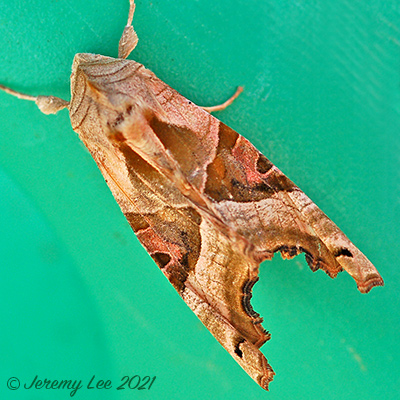
 |
|
Scientific Classifications explained » Amphibians » Ants » Aphids » Bees » Beetles » Birds » Bugs » Butterflies » Caterpillars » Damselflies » Dragonflies » Earwigs » Flies » Frog/Leafhoppers » Fungi » Galls » Grasshoppers » Harvestmen » Hoverflies » Lacewings » Ladybirds » Leaf Mines » Lichens » Mammals » Millipedes » Mosses » Moths » Sawflies » Slugs » Snails » Spiders » Trees & Shrubs » Wasps » Wild Flowers » Woodlice » Postboxes |
UK Nature > Moths > Phlogophora meticulosa

Scientific Name: Phlogophora meticulosa Common Name: Angle Shades Phlogophora meticulosa, more commonly known as the Angle Shades, is a highly distinctive medium-sized moth, generally seen on the wing from May to October as the result of two broods. It rests with its wings folded longitudinally, giving the appearance of a withered leaf. The species is a common migrant and can be found in large numbers in coastal locations. The caterpillars are stout and green or brownish, with faint stripes on every segment. Larvae that hatch in autumn overwinter as caterpillars and pupate in the soil the following spring to produce the first generation of adults that year. The caterpillars feed on a wide range of plants including Dock (Rumex sp.) and Stinging Nettles (Urtic dioica). This moth is common throughout the UK in parks and gardens, as well as woodland edges, scrub and hedgerows. |
|

https://www.uknature.co.uk is a website dedicated to showing the immense diversity of UK nature and wildlife. Our vast range of habitats, from lowland arable to snow covered mountains, from storm-ravaged coastlines to peaceful inland freshwater lakes and rivers, from dry, sandy heaths to deciduous and coniferous forests, all these habitats contribute to the abundance of UK nature. We have wild birds in huge numbers either residing or visiting our shores (597 recorded species as at July 2013) and we must also not forget the humble back garden with its grass lawns, flower beds filled with nectar rich flowers, shrubs and trees, all designed to attract huge numbers of insects such as bees, moths, butterflies and hoverflies; and finally the small ponds which provide safe havens for frogs, toads, newts and even slow worms and grass snakes. www.uknature.co.uk is the showcase for my personal passion, photographing uknature in all its glory. I sincerely hope you all enjoy the fruits of my labours. This site and all images contained therein is © Jeremy Lee 2004 - 2025. All Rights Reserved. Site design by Jeremy Lee. Site development & IT Support by Stuart Lee. |